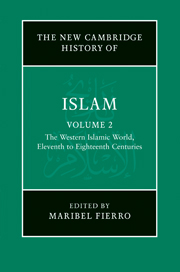Book contents
- Frontmatter
- Introduction
- PART I AL-ANDALUS AND NORTH AND WEST AFRICA (ELEVENTH TO FIFTEENTH CENTURIES)
- PART II EGYPT AND SYRIA (ELEVENTH CENTURY UNTIL THE OTTOMAN CONQUEST)
- PART III MUSLIM ANATOLIA AND THE OTTOMAN EMPIRE
- PART IV NORTH AND WEST AFRICA (SIXTEENTH TO EIGHTEENTH CENTURIES)
- PART V RULERS, SOLDIERS, PEASANTS, SCHOLARS AND TRADERS
- 19 State formation and organisation
- 20 Conversion to Islam: from the ‘age of conversions’ to the millet system
- 21 Taxation and armies
- 22 Trade
- 22A Muslim trade in the late medieval Mediterranean world
- 22B Overland trade in the western Islamic world (fifth–ninth/eleventh–fifteenth centuries)
- 22C Trade in the Ottoman lands to 1215/1800
- 23 The ʿulamāʾ
- Glossary
- Bibliography
- Index
- References
22C - Trade in the Ottoman lands to 1215/1800
from 22 - Trade
Published online by Cambridge University Press: 28 March 2011
- Frontmatter
- Introduction
- PART I AL-ANDALUS AND NORTH AND WEST AFRICA (ELEVENTH TO FIFTEENTH CENTURIES)
- PART II EGYPT AND SYRIA (ELEVENTH CENTURY UNTIL THE OTTOMAN CONQUEST)
- PART III MUSLIM ANATOLIA AND THE OTTOMAN EMPIRE
- PART IV NORTH AND WEST AFRICA (SIXTEENTH TO EIGHTEENTH CENTURIES)
- PART V RULERS, SOLDIERS, PEASANTS, SCHOLARS AND TRADERS
- 19 State formation and organisation
- 20 Conversion to Islam: from the ‘age of conversions’ to the millet system
- 21 Taxation and armies
- 22 Trade
- 22A Muslim trade in the late medieval Mediterranean world
- 22B Overland trade in the western Islamic world (fifth–ninth/eleventh–fifteenth centuries)
- 22C Trade in the Ottoman lands to 1215/1800
- 23 The ʿulamāʾ
- Glossary
- Bibliography
- Index
- References
Summary
Introduction
Competing political and economic strategies informed the Ottoman state’s policies towards commerce and merchants. At the core of the economic worldview of the sultans and their advisers was an appreciation of the revenues that the transit trade of luxury goods produced. The fifth/eleventh-century Qutadghu Bilig said of merchants, ‘associate with them as they come and go and do business with them, and give them what they require. For they have acquired all the choice and beautiful and desirable things of the world.’ It was a sentiment with which the Ottoman elite would agree. The sultans were also acutely aware of the strategic possibilities of trade, both as a weapon against their enemies and as a way of rewarding allies. Lastly, as the empire expanded and Istanbul’s population grew to number in the hundreds of thousands, the Ottoman court sought to implement policies to ensure the flow of vital commodities to the capital in order to foster social stability. Further complicating the picture, prominent jurists in the empire pronounced some of the policies implemented to achieve these strategic goals as being contrary to Islamic legal traditions. Those, as interpreted by the judges in the empire’s Muslim courts, supported the free flow of trade and established a bias in favour of Muslim traders. Given these competing aims, those who governed the empire were not always consistent in their approach to trade as the Ottomans sought to keep pace with shifts in the global patterns of commerce that were occurring outside the sultan’s realm.
- Type
- Chapter
- Information
- The New Cambridge History of Islam , pp. 665 - 678Publisher: Cambridge University PressPrint publication year: 2010

